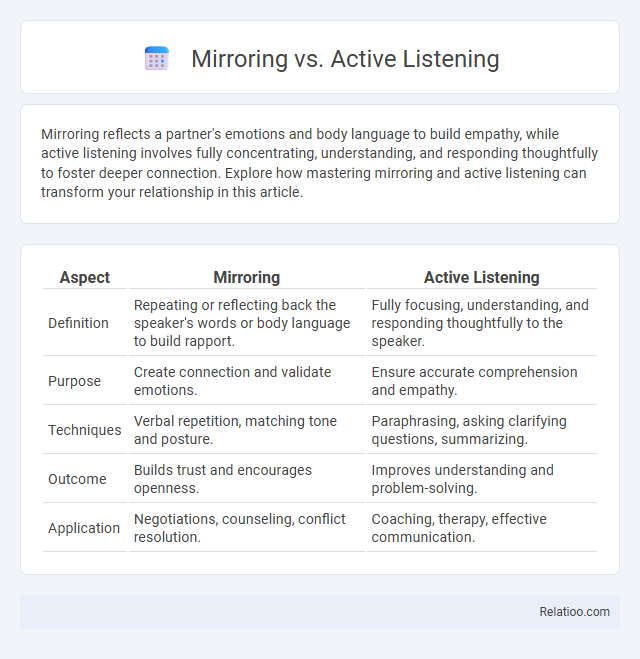Mirroring reflects a partner's emotions and body language to build empathy, while active listening involves fully concentrating, understanding, and responding thoughtfully to foster deeper connection. Explore how mastering mirroring and active listening can transform your relationship in this article.
Table of Comparison
| Aspect | Mirroring | Active Listening |
|---|---|---|
| Definition | Repeating or reflecting back the speaker's words or body language to build rapport. | Fully focusing, understanding, and responding thoughtfully to the speaker. |
| Purpose | Create connection and validate emotions. | Ensure accurate comprehension and empathy. |
| Techniques | Verbal repetition, matching tone and posture. | Paraphrasing, asking clarifying questions, summarizing. |
| Outcome | Builds trust and encourages openness. | Improves understanding and problem-solving. |
| Application | Negotiations, counseling, conflict resolution. | Coaching, therapy, effective communication. |
Introduction to Mirroring and Active Listening
Mirroring involves reflecting another person's verbal and nonverbal behaviors to build rapport and enhance communication, emphasizing empathy and understanding. Active listening requires fully concentrating, understanding, and responding thoughtfully to the speaker, ensuring their message is accurately received and acknowledged. Both techniques improve interpersonal interactions by fostering connection and clarity in conversations.
Defining Mirroring in Communication
Mirroring in communication involves subtly reflecting your conversation partner's body language, tone, and expressions to foster rapport and build trust. It enhances understanding and connection by signaling empathy and attentiveness, making Your interactions more engaging and effective. Unlike active listening, which focuses on verbal feedback and comprehension, mirroring emphasizes nonverbal synchronization to deepen interpersonal communication.
What Is Active Listening?
Active listening is a communication technique that involves fully concentrating, understanding, responding, and remembering what the speaker says. Unlike mirroring, which replicates the speaker's words or body language to create rapport, active listening prioritizes empathetic engagement and feedback to ensure accurate comprehension. This skill is essential in conflict resolution, counseling, and effective teamwork for enhancing interpersonal connections.
Key Differences Between Mirroring and Active Listening
Mirroring involves subtly reflecting your conversation partner's body language, tone, or words to build rapport and show empathy, while active listening requires fully concentrating, understanding, and responding thoughtfully to the speaker's message. You enhance communication effectiveness by recognizing that mirroring emphasizes nonverbal cues and emotional alignment, whereas active listening centers on verbal input and comprehension. Both techniques improve interpersonal connections, but their key difference lies in mirroring's focus on behavioral mimicry versus active listening's emphasis on cognitive engagement.
Psychological Benefits of Mirroring
Mirroring fosters psychological benefits by enhancing empathy and building trust, which helps individuals feel understood and validated in social interactions. This technique aligns nonverbal cues such as body language and tone, promoting emotional connection and reducing anxiety. Active listening and mirroring both improve communication, but mirroring's emphasis on subconscious imitation uniquely reinforces rapport and deepens interpersonal bonds.
Cognitive Impact of Active Listening
Active listening significantly enhances cognitive processing by fostering deeper understanding and retention of information through focused attention and meaningful feedback. In contrast to mere mirroring, which often replicates verbal and nonverbal cues without engaging comprehension, active listening promotes critical thinking and empathetic responses. This cognitive engagement strengthens memory pathways and improves interpersonal communication effectiveness.
Practical Examples: Mirroring vs. Active Listening
Mirroring involves subtly imitating your conversation partner's body language, tone, or words to build rapport and trust, such as matching their posture or repeating key phrases. Active listening requires fully concentrating on what the other person is saying, reflecting their emotions, and providing feedback, like summarizing their points to ensure understanding. Your effective communication improves when combining mirroring with active listening, using both nonverbal cues and verbal affirmations to create a deeper connection.
When to Use Mirroring in Conversations
Mirroring is most effective when you want to build rapport quickly by subtly reflecting the other person's body language, tone, or words, making them feel understood and comfortable. Active listening is best for deeply understanding and responding thoughtfully to the speaker's message, while simple repetition or paraphrasing reinforces clarity and confirms comprehension. You should use mirroring in conversations where empathy and connection are essential, such as in negotiations, counseling, or relationship-building scenarios.
Situations Best Suited for Active Listening
Active listening is best suited for situations requiring deep understanding and emotional connection, such as conflict resolution or counseling sessions. It involves fully concentrating, understanding, responding, and remembering what is being said, which helps build trust and rapport. Unlike mirroring, which focuses on nonverbal cues, active listening engages verbal feedback to clarify and validate the speaker's message effectively.
Choosing the Right Approach for Effective Communication
Choosing the right approach between mirroring, active listening, and a combination of both hinges on the communication context and desired outcomes. Mirroring involves subtly reflecting the speaker's body language and tone to build rapport and trust, while active listening emphasizes fully concentrating, understanding, and responding thoughtfully to the speaker's message. For effective communication, integrating mirroring with active listening enhances empathy and connection, ensuring messages are accurately received and relationships strengthened.

Infographic: Mirroring vs Active Listening
 relatioo.com
relatioo.com